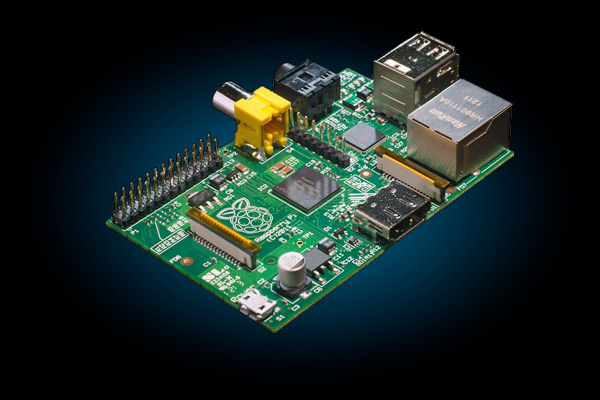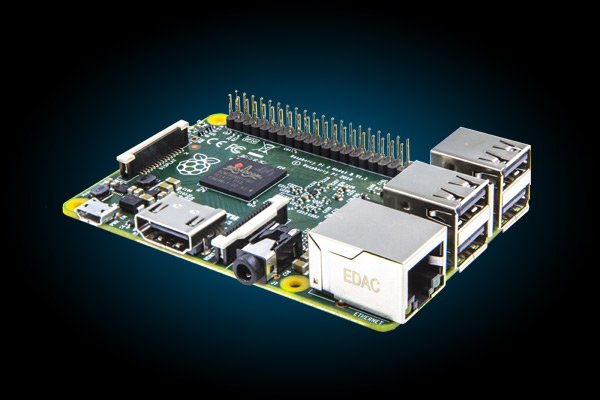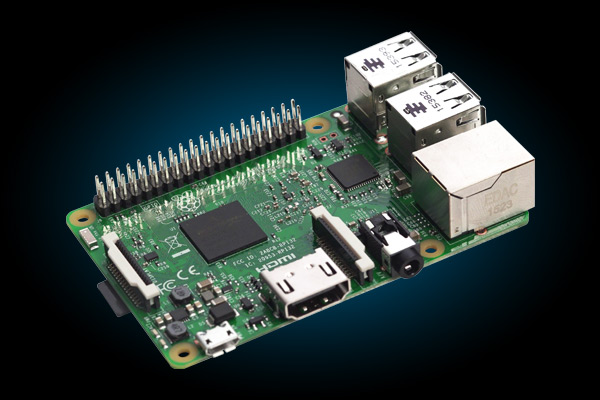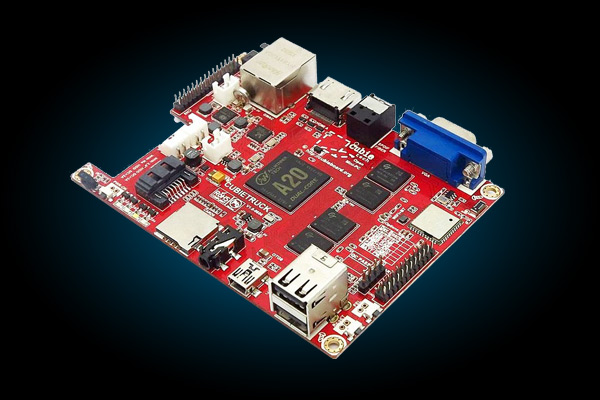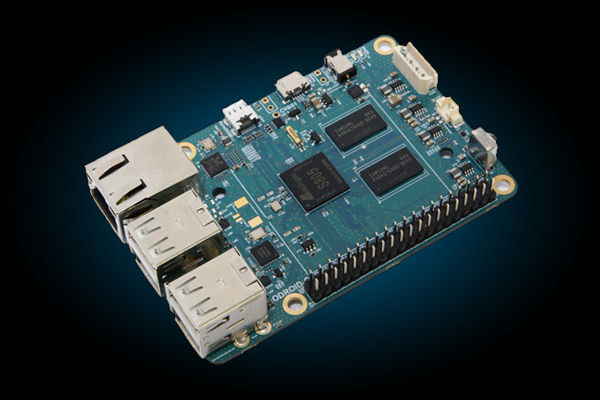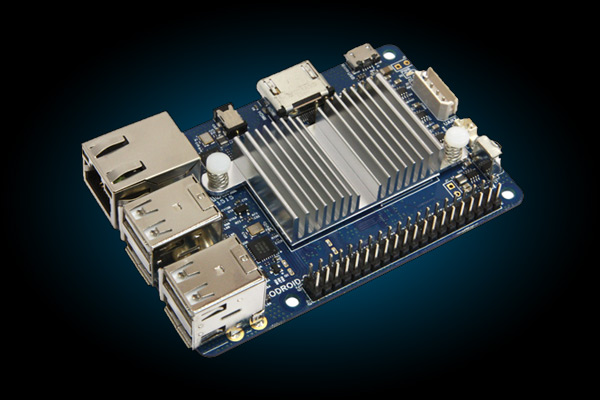Certified devices
RuneAudio is certified to work on a number of devices, including the following:
 Raspberry Pi
Raspberry Pi Raspberry Pi 2
Raspberry Pi 2 Raspberry Pi 3
Raspberry Pi 3 Beaglebone Black
Beaglebone Black CuBox
CuBox UDOO
UDOO Cubietruck
Cubietruck ODROID C1
ODROID C1 ODROID C1+
ODROID C1+
Raspberry Pi
The Raspberry Pi is a credit-card sized computer that plugs into your TV and a keyboard. It’s a capable little PC which can be used for many of the things that your desktop PC does, like spreadsheets, word-processing and games. It also plays high-definition video. We want to see it being used by kids all over the world to learn programming.
Hardware specifications
- SoC Broadcom BCM2835 (CPU, GPU, DSP, and SDRAM)
- CPU: 700 MHz ARM1176JZF-S core (ARM11 family)
- GPU: Broadcom VideoCore IV, OpenGL ES 2.0, 1080p30 h.264/MPEG-4 AVC high-profile decoder
- Memory RAM: 512 MB
- Video outputs: Composite RCA, HDMI
- Audio outputs: 3.5 mm jack, HDMI
- Onboard storage: SD, MMC, SDIO card slot
- 10/100 Ethernet RJ45 onboard network
- Wi-Fi with USB dongle
- Storage via SD/ MMC/ SDIO card slot
- 2 USB port
- Power: 700 mA at 5V (3.5 W) – the use of a 2A power source is strongly suggested
Choose this platform if:
- You already have a Raspberry Pi which is not being used
- Your budget is really small and you need the most affordable solution
- You want to use it with a I2S DAC (and you don’t mind a bit of soldering)
- You need or want to build a multi-device system (i.e. multiroom)
- You simply enjoy tinkering with a Pi
Raspberry Pi 2
The Raspberry Pi 2 Model B is the second generation Raspberry Pi. It replaced the original Raspberry Pi 1 Model B+ in February 2015. The Raspberry Pi 2 has an identical form factor to the previous (Pi 1) Model B+ and has complete compatibility with Raspberry Pi 1.
Hardware specifications
- quad-core ARM Cortex-A7
- SoC Broadcom BCM2836 (CPU, GPU, DSP, and SDRAM)
- CPU: 900 MHz ARM Cortex-A7 quad core
- GPU: Broadcom VideoCore IV, OpenGL ES 2.0, 1080p30 h.264/MPEG-4 AVC high-profile decoder
- Memory RAM: 1 GB LPDDR2 SDRAM
- Video outputs: HDMI, composite video (PAL and NTSC) via 3.5 mm TRRS jack shared with audio out
- Audio outputs: 3.5 mm jack, HDMI
- Onboard storage: microSD card slot
- 10/100 Ethernet RJ45 onboard network
- Wi-Fi with USB dongle
- 4 USB port
- Power: 800 mA at 5V (4 W) – the use of a 2A power source is strongly suggested
Choose this platform if:
- You aim for the bang for the buck solution
- You want more horsepower over the same popular features of the first Raspberry Pi but at the same price
Raspberry Pi 3
The Raspberry Pi 3 is the third generation Raspberry Pi. It replaced the Raspberry Pi 2 Model B in February 2016. The Raspberry Pi 3 has an identical form factor to the previous Pi 2 (and Pi 1 Model B+) and has complete compatibility with Raspberry Pi 1 and 2.
Hardware specifications
- quad-core ARM Cortex-A8
- SoC Broadcom BCM2837 (CPU, GPU, DSP, and SDRAM)
- CPU: 1.2GHz ARM Cortex-A8 quad core
- GPU: Broadcom Dual Core VideoCore IV, OpenGL-ES 1.1/2.0, Full HD 1080p30
- Memory RAM: 1 GB LPDDR2 SDRAM
- Video outputs: HDMI, composite video (PAL and NTSC) via 3.5 mm TRRS jack shared with audio out
- Audio outputs: 3.5 mm jack, HDMI
- Onboard storage: microSD card slot
- 10/100 Ethernet RJ45 onboard network
- Wi-Fi BCM43143 2,4GHz WLAN b/g/n
- Bluetooth 4.1 Low Energy
- 4 USB port
- Power: 900 mA at 5V (4 W) – the use of a 2.5A power source is strongly suggested
Choose this platform if:
- You aim for the bang for the buck solution
- You want more horsepower over the same popular features of the first Raspberry Pi 2 but at the same price
- You need integrated Bluetooh and/or Wi-Fi
Beaglebone Black
BeagleBone Black is a $45 MSRP community-supported development platform for developers and hobbyists. Boot Linux in under 10 seconds and get started on development in less than 5 minutes with just a single USB cable.
Hardware specifications
- Processor: AM335x 1GHz ARM® Cortex-A8
- 512MB DDR3 RAM
- 2GB 8-bit eMMC on-board flash storage
- 3D graphics accelerator
- NEON floating-point accelerator
- 2x PRU 32-bit microcontrollers
- USB client for power & communications
- USB host
- Ethernet
- HDMI
- 2x 46 pin headers
Choose this platform if:
- You need I2S out
- You want a full open source hardware solution
- You want to expand your solution with cape plug-in boards
CuBox
The SolidRun CuBox is is the world's smallest desktop computer. The high performance, low power HTPC and media centre is packed into a tiny cube, just 2 × 2 × 2 inches in size.
Weighing 91 grams (0.2lb, 3.2oz), the highly-efficient fanless computer runs happily on less than 3W power*, even when streaming and decoding full-screen 1080p video - and it's all available as an open source development platform!
Hardware specifications
- Linux based distributions like Ubuntu, Debian and others
- Android
- 800 MHz dual issue ARM PJ4 processor, VFPv3, wmmx SIMD and 512KB L2 cache.
- 1080p Video Decode Engine
- OpenGL|ES 2.0 graphic engine
- HDMI 1080p Output (with CEC function)
- 1GByte DDR3 at 800MHz
- Gigabit Ethernet, SPDIF (optical audio), eSata 3Gbps, 2xUSB 2.0, micro-SD, micro-USB (console)
- Standard Infra-red receiver for 38KHz based IR controllers.
- No JTAG required. Unbrickable for Developers (**)
Choose this platform if:
- You need something ready built, boxed and with PSU
- You need a built-in IrDA for a remote control
- You need optical S/PDIF out
UDOO
UDOO is a mini PC that can run either Android or Linux, with Arduino - compatible board embedded.
UDOO is an open hardware, low-cost computer equipped with an ARM i.MX6 Freescale processor for Android and Linux, alongside Arduino DUE's ARM on the same board!
Hardware specifications
- Freescale i.MX 6 ARM Cortex-A9 CPU Dual/Quad core 1GHz
- Integrated graphics, each processor provides 3 separated accelerators for 2D, OpenGL® ES2.0 3D and OpenVG™
- Atmel SAM3X8E ARM Cortex-M3 CPU (same as Arduino Due)
- RAM DDR3 1GB
- 76 fully available GPIO
- Arduino-compatible R3 1.0 pinout
- HDMI and LVDS + Touch (I2C signals)
- Ethernet RJ45 (10/100/1000 MBit)
- WiFi Module
- Mini USB and Mini USB OTG
- USB type A (x2) and USB connector (requires a specific wire)
- Analog Audio and Mic
- SATA (Only Quad-Core version)
- Camera connection
- Micro SD (boot device)
- Power Supply 12V and External Battery connector
Choose this platform if:
- You need built-in Wi-Fi
- You need more CPU horsepower
- You need a built-in IrDA for a remote control
- You need power and flexibility for any kind of expansions (for example, connecting a touch screen)
- You want a decent quality analog output without an external USB DAC
Cubietruck
Cubietruck is the 3rd board from Cubieteam, they also named it Cubieboard3.
The Cubietruck is basically a PC-on-a-board, featuring Allwinner’s dual-core ARM Cortex-A7 processor.
With 2GB RAM, WiFi, Bluetooth, Gigabit Ethernet, USB / HDMI and VGA ports it is a ideal candidate for a music player.
It measures about 4.3″ x 3.1″ and with the onboard SATA 2.0 interface it can be used with a hard drive or solid state disk.
Hardware specifications
- SOC AllWinnerTech A20
- CPU: 1Ghz ARM® Cortex™-A7 Dual-Core
- GPU: ARM® Mali400 MP2 Complies with OpenGL ES 2.0/1.1
- Memory RAM :1GB or 2GB DDR3@480MHz (960MTPS)
- Video outputs: HDMI&VGA 1080P display output on-board
- Audio outputs: HDMI, Toslink (SPDIF Optical), Headphone
- 10M/100M/1G Ethernet RJ45 onboard network
- Wifi+BT wireless connection with antenna on-board
- SATA 2.0 interface support 2.5' HDD, (3.5' HDD needs a dedicated power supply)
- Storage solution: NAND and MicroSD
- 2 x USB HOST, 1 x OTG, , 1 x IR, 4 x LEDs, 3 x Keys
- Power: DC5V @ 2.5A with HDD, support for Li-battery & RTC
- 54 extended pins including I2S, I2C, SPI, CVBS, LRADC x2,UART, PS2, PWMx2, TS/CSI, IRDA, LINEIN&FMIN&MICIN, TVINx4 on pinheader
- PCB size: 11cm x 8cm x 1.4mm
Choose this platform if:
- You need a very complete and fully accessorized board
- You need good CPU horsepower
- You need a built-in Wi-Fi for hotspot capability
- You want internal NAND memory
- You want Gigabit Ethernet
ODROID C1
Don't put up with the slow single core computer anymore.
If you are considering a tiny computer for general purpose computing, software development or as a project platform, the ODROID-C1 will give you a lot more satisfaction and fun with incredible performance for a very low price. The ODROID-C1 has many advantages over the Raspberry Pi. The processor is an S805 1.5GHz Quad-core from Amlogic with 1GByte DDR3 RAM, Gigabit Ethernet and IR-receiver. If you use an eMMC storage, you can get about two to three times faster storage I/O read performance.
Hardware specifications
- Amlogic ARM® Cortex®-A5(ARMv7) 1.5Ghz quad core CPUs
- Mali™-450 MP2 GPU (OpenGL ES 2.0/1.1 enabled for Linux and Android)
- 1Gbyte DDR3 SDRAM
- Gigabit Ethernet
- 40pin GPIOs
- eMMC4.5 HS200 Flash Storage slot / UHS-1 SDR50 MicroSD Card slot
- USB 2.0 Host x 4, USB OTG x 1
- Infrared(IR) Receiver
Choose this platform if:
- You do not need I2S (Inter-IC Sound)
- You aim for the bang for the buck solution
- You want more horsepower and higher network bandwith (Gigabit Ethernet)
ODROID C1+
The C1+ is the latest revision of the original C1.
It replaced the original C1 in July 2015.
Because of the changes, the original cases and heat sinks are not compatible.
Hardware specifications
Same as the ODROID C1 above, but with the following differences:
- Full-sized Type-A HDMI port instead of micro-HDMI
- Heatsink now standard instead of optional
- I2S bus (7-pin header) that supports optional HiFi audio add-on board
- CEC function now independent of RTC battery
- Power support for USB OTG in addition to DC barrel jack
- Improved SD card compatibility
Choose this platform if:
- You DO need I2S (Inter-IC Sound)
- You aim for the bang for the buck solution
- You want more horsepower and higher network bandwith (Gigabit Ethernet)

